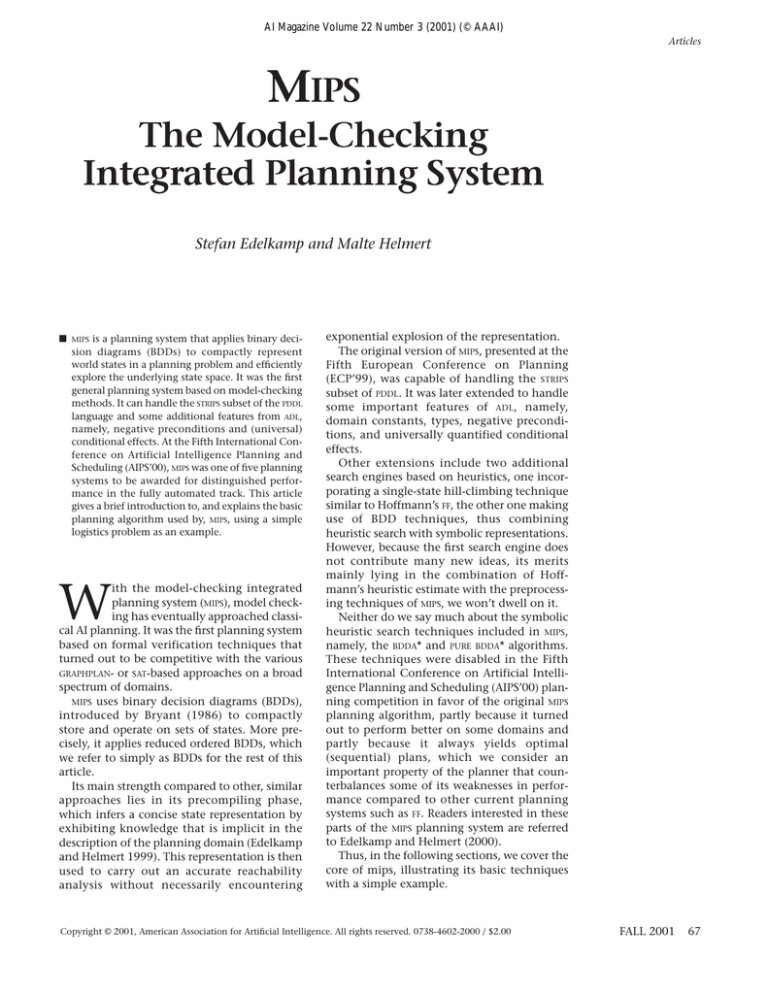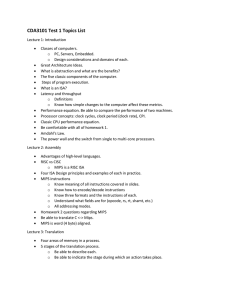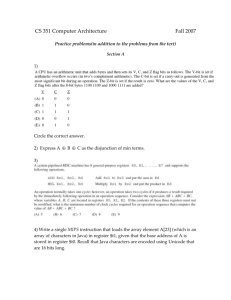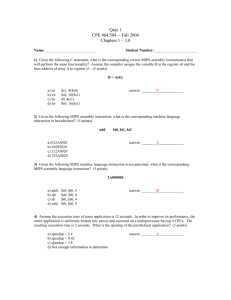
AI Magazine Volume 22 Number 3 (2001) (© AAAI)
Articles
MIPS
The Model-Checking
Integrated Planning System
Stefan Edelkamp and Malte Helmert
■
is a planning system that applies binary decision diagrams (BDDs) to compactly represent
world states in a planning problem and efficiently
explore the underlying state space. It was the first
general planning system based on model-checking
methods. It can handle the STRIPS subset of the PDDL
language and some additional features from ADL,
namely, negative preconditions and (universal)
conditional effects. At the Fifth International Conference on Artificial Intelligence Planning and
Scheduling (AIPS’00), MIPS was one of five planning
systems to be awarded for distinguished performance in the fully automated track. This article
gives a brief introduction to, and explains the basic
planning algorithm used by, MIPS, using a simple
logistics problem as an example.
MIPS
W
ith the model-checking integrated
planning system (MIPS), model checking has eventually approached classical AI planning. It was the first planning system
based on formal verification techniques that
turned out to be competitive with the various
GRAPHPLAN- or SAT-based approaches on a broad
spectrum of domains.
MIPS uses binary decision diagrams (BDDs),
introduced by Bryant (1986) to compactly
store and operate on sets of states. More precisely, it applies reduced ordered BDDs, which
we refer to simply as BDDs for the rest of this
article.
Its main strength compared to other, similar
approaches lies in its precompiling phase,
which infers a concise state representation by
exhibiting knowledge that is implicit in the
description of the planning domain (Edelkamp
and Helmert 1999). This representation is then
used to carry out an accurate reachability
analysis without necessarily encountering
exponential explosion of the representation.
The original version of MIPS, presented at the
Fifth European Conference on Planning
(ECP’99), was capable of handling the STRIPS
subset of PDDL. It was later extended to handle
some important features of ADL, namely,
domain constants, types, negative preconditions, and universally quantified conditional
effects.
Other extensions include two additional
search engines based on heuristics, one incorporating a single-state hill-climbing technique
similar to Hoffmann’s FF, the other one making
use of BDD techniques, thus combining
heuristic search with symbolic representations.
However, because the first search engine does
not contribute many new ideas, its merits
mainly lying in the combination of Hoffmann’s heuristic estimate with the preprocessing techniques of MIPS, we won’t dwell on it.
Neither do we say much about the symbolic
heuristic search techniques included in MIPS,
namely, the BDDA* and PURE BDDA* algorithms.
These techniques were disabled in the Fifth
International Conference on Artificial Intelligence Planning and Scheduling (AIPS’00) planning competition in favor of the original MIPS
planning algorithm, partly because it turned
out to perform better on some domains and
partly because it always yields optimal
(sequential) plans, which we consider an
important property of the planner that counterbalances some of its weaknesses in performance compared to other current planning
systems such as FF. Readers interested in these
parts of the MIPS planning system are referred
to Edelkamp and Helmert (2000).
Thus, in the following sections, we cover the
core of mips, illustrating its basic techniques
with a simple example.
Copyright © 2001, American Association for Artificial Intelligence. All rights reserved. 0738-4602-2000 / $2.00
FALL 2001
67
Articles
A
A
0
1
1
0
B
B
0
1
0
1
0
0
0
1
B
0
0
1
1
Figure 1. Two Equivalent Binary Decision Diagrams,
a Nonreduced One and a Reduced One.
The 1 sink can only be reached by following the edges labeled 1 from A and B; thus, the represented Boolean
function (A, B) evaluates to true if and only if A and B are true.
Binary Decision Diagrams:
Why and for What?
MIPS is based on satisfiability checking, which is
indeed not a new idea. However, MIPS was the
first SAT-based planning system to make use of
binary decision diagrams to avoid (or at least
lessen) the costs associated with the exponential blowup of the Boolean formulas involved
as problem sizes get bigger. Since the early days
of MIPS, other planning systems based on BDDs
have emerged, most notably Fourman’s PROPPLAN and Störr’s BDDPLAN. We believe that the
key advantage of MIPS compared to those systems lies in its preprocessing algorithms.
Thus, it looks like BDDs are currently considered an interesting topic in AI planning. Why
is that? There is no doubt about the usefulness
of this data structure. Nowadays, BDDs are a
fundamental tool in various research areas,
such as model checking and the synthesis and
verification of hardware circuits. In AI planning, they are mainly useful because of their
ability to efficiently represent huge sets of
states commonly encountered in state-space
search.
Without going into too much detail, a BDD
is a data structure for efficiently representing
Boolean functions, mapping bit strings of a
fixed length to either true or false. A BDD is a
directed acyclic graph with a single root node
and two sinks, labeled 1 and 0, respectively. For
evaluating the represented function for a given
68
AI MAGAZINE
input, a path is traced from the root node to
one of the sinks, quite similar to the way decision trees are used. What distinguishes BDDs
from decision trees is the use of certain reductions, detecting unnecessary variable tests and
isomorphisms in subgraphs, leading to a
unique representation that is polynomial in
the length of the bit strings for many interesting functions. Figure 1 provides an example.
Among the operations supported by current
BDD packages are all usual Boolean connectors
such as and and or as well as constant time satisfiability and equality checking. MIPS uses the
BUDDY package by Jørn Lind-Nielsen, which we
considered particularly useful for our purposes
because of its ability to form groups of several
Boolean variables to easily encode finitedomain integers.
In MIPS, BDDs are used for two purposes: (1)
representing sets of states and (2) representing
state transitions.
Binary Decision Diagrams for
Representing Sets of States
Given a fixed-length binary code for the state
space of a planning problem, BDDs can be used
to represent the characteristic function of a set
of states (which evaluates to true for a given bit
string, that is, state, if and only if it is a member
of this set). The characteristic function can be
identified with the set itself.
Unfortunately, there are many different pos-
Articles
sibilities to come up with an encoding of states
in a planning problem, and the more obvious
ones seem to waste a lot of space, which often
leads to bad performance of BDD algorithms. It
seems worthwhile to spend some effort on
finding a “good” encoding, which is where the
preprocessing of MIPS enters the stage.
Let us consider a very simple example of a
planning problem where a truck is supposed to
deliver a package from Los Angeles to San Francisco. The initial situation in PDDL notation is
given by (PACKAGE package), (TRUCK truck),
(LOCATION los-angeles), (LOCATION sanfrancisco), (AT package los-angeles), and (AT
truck los-angeles). Goal states have to satisfy
the condition (AT package san-francisco). The
domain provides three action schemata named
LOAD to load a truck with a certain package at
a certain location, the inverse operation
UNLOAD, and DRIVE to move a truck from
one location to another.
The first preprocessing step of MIPS will detect
that only the AT (denoting the presence of a
given truck or package at a certain location)
and IN predicates (denoting that a package is
loaded in a certain truck) are fluents and, thus,
need to be encoded. The labeling predicates
PACKAGE, TRUCK, and LOCATION are not
affected by any operator and, thus, do not need
to be specified in a state encoding.
In a next step, some mutual exclusion constraints are discovered. In our case, we detect
that a given object will always be at or in at
most one other object, so propositions such as
(AT package los-angeles) and (IN package truck)
are mutually exclusive.
This result is complemented by what we call
fact-space exploration: Ignoring negative
(delete) effects of operators, we exhaustively
enumerate all propositions that can be satisfied
by any legal sequence of actions applied to the
initial state, thus ruling out illegal propositions
such as (IN los-angeles package), (AT package
package), or (IN truck san-francisco).
Now all the information that is needed to
devise an efficient state-encoding schema for
this particular problem is at the planner’s
hands. MIPS discovers that three Boolean variables A, B, and C are needed. The first one is
required for encoding the current city of the
truck, where A is set if (AT truck san-francisco)
holds true, and A is cleared otherwise, that is,
if (AT truck los-angeles) holds true. The other
two variables B and C encode the status of the
package: Both are cleared if it is at Los Angeles,
C but not B is set if it is at San Francisco, and B
but not C is set if it is inside the truck.
We can now rephrase initial state and goal
test as Boolean formulas, which can, in turn, be
A
0
B
B
0
1
C
0
1
0
1
1
1
C
0
0
0
1
1
Figure 2. Binary Decision Diagrams for the Characteristic Functions
of the Initial State, init(A, B, C) = ¬ A ¬ B ¬ C, and of
Goal States, goal(A, B, C) = ¬ B C.
represented as BDDs: ¬ A ¬ B ¬ C denotes
the initial situation, and the goal is reached in
every state where ¬ B C holds true. The corresponding BDDs are illustrated in figure 2.
Binary Decision Diagrams for
Representing State Transitions
What have we achieved so far? We were able to
reformulate the initial and final situations as
BDDs. As an end in itself, this representation
does not help too much. We are interested in a
sequence of actions (or transitions) that transforms an initial state into one that satisfies the
goal condition.
Transitions are formalized as relations, that is,
as sets of tuples of predecessor and successor
states or, alternatively, as the characteristic function of such sets, Boolean formulas using variables A, B, C for the old situation and A′, B′, C′
for the new situation. For example, the action
(DRIVE truck los-angeles san-francisco), which
is applicable if and only if the truck currently is
in Los Angeles and has as its effect a change of
location of the truck, not altering the status of
the package, can be formalized using the
Boolean formula ¬ A A′ (B ↔ B′) (C ↔ C′).
FALL 2001 69
Articles
A
A
0
0
A′ 1
A′
B
B′
B′
B
1
0
0
1
B′
B′
B′
B′
0
1
0
1
C
C
0
0
B
1
0
C
1
1
C′
C′
0
1
1
A′
1
0
1
0
1
0
0
0
1
C′
C′
1
1
Figure 3. The Left Binary Decision Diagram Represents the Single Action
(DRIVE truck los-angeles san-francisco), the Right One the Disjunctive
of All Possible Actions and, Thus, the Complete Transition Relation.
The 0 sink and edges leading to it have been omitted for aesthetic reasons.
By conjoining this formula with any formula
describing a set of states using variables A, B,
and C introduced before and querying the BDD
engine for the possible instantiations of (A’, B’,
C’), we can calculate all states that can be
reached by driving the truck to San Francisco
in some state from the input set. This query for
reachable states, put shortly, is the relational
product operator that is used at the core of MIPS
to calculate a set of successor states from a set
of predecessor states and a transition relation.
Of course, we have more than one action at our
disposal (otherwise, planning would not be all
that interesting), so rather than using the transition formula denoted earlier, we build one
such formula for each feasible action (adding a
no-op action for technical reasons) and calculate the disjunction of those, illustrated in figure 3.
Calculating the relational product for the
operators in our example, starting from the set
containing only the initial state, we get a set of
70
AI MAGAZINE
three states—(1) the initial state, (2) one state
where the truck has moved, and (3) one where
the package was picked up—represented by a
BDD with three internal nodes. Repeating this
process, this time starting from the state set
just calculated, we get a set of four states represented by a BDD with a single internal node,
and a third iteration finally yields a state where
the goal has been reached (figure 4). The goal
condition can be tested by building the conjunction of the current state set and goal state
BDDs and testing for satisfiability.
By keeping the intermediary BDDs, a legal
sequence of states linking the initial state to a
goal state can then easily be extracted, which,
in turn, can be used to find a corresponding
sequence of actions.
Evaluation of the
MIPS Algorithm
It is not hard to see that given enough computational and memory resources, MIPS will find a
correct plan if one exists. As it performs a
breadth-first search in the state space, the first
solution found will consist of a minimal number of steps. The algorithm will also terminate
on unsolvable problem instances; the breadthfirst search will eventually reach a fix point,
which can easily be detected by comparing the
successor BDD to the predecessor BDD after
calculating the relational product. Thus, the
algorithm is complete and optimal.
However, it is not blindingly fast, so various
efforts were made to speed it up, mostly wellknown standard techniques in symbolic search
such as forward-set simplification. A bigger gain
in efficiency was achieved by using bidirectional search, which can be incorporated into the
algorithm in a straightforward fashion. One
problem that arises in this context is that in
some planning domains, backward iterations
are far more expensive than forward iterations,
and it is not trivial to decide when to perform
which. We tried three different metrics to
decide on the direction of the next exploration
step: (1) BDD size, (2) number of states encoded, and (3) time spent on the last exploration
step in this direction. In our experiments, the
last metric turned out to be most effective.
Outlook
As for the basic exploration algorithm, big
improvements leading to a dramatically better
performance are not to be expected for the
near future, with the possible exception of
transition function splitting, which still needs
to be incorporated into the system.
Articles
From the algorithmic repertoire of MIPS, the
heuristic symbolic search engine, which until
now has produced promising results but is still
lacking in some domains, is getting the most
attention at the moment (Edelkamp 2001). It
might also be worthwhile to investigate the
issue of optimal parallel plans, building on the
work done by Haslum and Geffner (2000) for
HSP.
Another research aim is the development of
precomputed informative and admissible estimates for explicit and symbolic search based
on heuristic pattern databases.
The single most important area of interest,
however, is certainly the extension of MIPS to
more general flavors of planning, such as conformant or strong cyclic planning where the
strengths of symbolic methods are much more
apparent than in the classical scenario (Cimatti
and Roveri 1999; Daniele, Traverso, and Vardi
1999).
Acknowledgment
We thank F. Reffel for his cooperation concerning this research. S. Edelkamp’s work is
supported by DFG in a project entitled “Heuristic Search and Its Application to Protocol Validation.”
A
A
1
0
B
A
B
0
0
C
0
1
1
B
0
1
0
C
0
1
C
0
1
C
0
0
1
Figure 4. Binary Decision Diagrams (BDDs) Representing the
Set of Reachable States after Zero, One, Two, and Three
Iterations of the Exploration Algorithm.
Note that the size (number of internal nodes) of a BDD does not necessarily grow
with the number of states represented. Edges leading to the 0 sink have been
omitted for aesthetic reasons.
References
Bryant, R. E. 1986. Graph-Based Algorithms for
Boolean Function Manipulation. IEEE Transactions
on Computers 35(8): 677–691.
Cimatti, A., and Roveri, M. 1999. Conformant Planning via Model Checking. In Recent Advances in AI
Planning, Volume 1809, eds. M. Fox and S. Biundo,
21–34. Lecture Notes in Artificial Intelligence. New
York: Springer-Verlag.
Daniele, M.; Traverso, P.; and Vardi, M. Y. 1999.
Strong Cyclic Planning Revisited. In Recent Advances
in AI Planning, Volume 1809, eds. M. Fox and S. Biundo, 35–40. Lecture Notes in Artificial Intelligence.
New York: Springer-Verlag.
Edelkamp, S. 2001. Directed Symbolic Exploration
and Its Application to AI Planning. Paper presented
at the Spring Symposium on Model-Based Validation
of Intelligence, 26–28 March, Stanford, California.
Edelkamp, S., and Helmert, M. 2000. On the Implementation of MIPS. Paper presented at the Fifth International Conference on Artificial Intelligence Planning and Scheduling, Workshop on Model-Theoretic
Approaches to Planning, 14 April, Breckenridge, Colorado.
Edelkamp, S., and Helmert, M. 1999. Exhibiting
Knowledge in Planning Problems to Minimize State
Encoding Length. In Recent Advances in AI Planning,
Volume 1809, eds. M. Fox and S. Biundo, 135–147.
Lecture Notes in Artificial Intelligence. New York:
Springer-Verlag.
International Conference on Artificial Intelligence
Planning and Scheduling, 140–149. Menlo Park,
Calif.: American Association for Artificial Intelligence.
Stefan Edelkamp is a research assistant for the Algorithms and Data Structures Group at the Institute for
Computer Science at the University of Freiburg. He
studied computer science and mathematics in Dortmund and Dublin and received his Ph.D. in computer science from the University of Freiburg on the subject of data structures and learning algorithms in
state space search. His current research interests
include sequential sorting, heuristic search, AI planning, model checking, and graph algorithms. His email address is edelkamp@informatik.uni-freiburg.
de.
Malte Helmert is currently working on his Ph.D. thesis with the Artificial Intelligence Group of the Institute for Computer Science at the University of
Freiburg. He studied computer science in Freiburg
and Durham. His current research interests include
AI planning, complexity theory, games, and computational geometry. His e-mail address is helmert@
informatik.uni-freiburg.de.
Haslum, P., and Geffner, H. 2000. Admissible Heuristics for Optimal Planning. In Proceedings of the Fifth
FALL 2001 71
Articles
Call for Papers and Participation
Eighteenth National Conference
on Artificial Intelligence
July 28–August 1 Shaw Convention Center, Edmonton, Alberta, Canada
Sponsored by the American Association for Artificial Intelligence
AAAI-02 is the Eighteenth National Conference on Artificial Intelligence (AI). The purpose of this conference is to promote research in AI
and scientific interchange among AI researchers, practitioners, and scientists and engineers in related disciplines.
The conference provides a forum for a broad range of topics, including (but not limited to) knowledge representation, machine learning,
autonomous agents, planning, robotics and machine perception, expert
systems, theorem proving, commonsense reasoning, probabilistic inference, constraint satisfaction, game playing, automated diagnosis, data
mining, natural language processing, neural networks, reinforcement
learning, and cognitive modeling.
As the national conference for all of AI, AAAI-02 is intended to play
a centralizing and unifying role that complements more specialized
conferences. To encourage papers that speak to the whole AI community, this year we will avoid multiple parallel sessions. Instead, all accepted papers will be presented as posters, and a subset will also be presented orally in a single plenary track. All papers will appear identically in
the proceedings, and all will be subject to the same rigorous review
process.
Timetable for Authors
■
■
January 21, 2002: Electronic submission of title page, abstract and
paper
January 22, 2002: Submission of two (2) paper copies to AAAI
office
March 15, 2002: Notification of acceptance or rejection
April 9, 2002: Camera-ready copy due at AAAI office
copy and electronic submissions may be no longer than 6 pages long
including references, and formatted in AAAI two-column camera ready
style. We cannot accept submissions by e-mail or fax. Please send papers
to:
AAAI-02
American Association for Artificial Intelligence
445 Burgess Drive
Menlo Park, CA 94025-3442
Telephone: 650-328-3123
Reviewing for AAAI-02 will be blind to the identities of the authors.
Details on formatting and preparing the paper for blind review can be
found at the authors’ web site noted above.
Submissions to Other Conferences or Journals
Papers submitted to this conference must not have been accepted for
publication elsewhere or be under review for another AI conference.
However, to encourage interdisciplinary contributions, we may consider work that has been submitted or presented in part to a forum outside
of AI. The guidelines of the AAAI policy on multiple submissions are
fully detailed at the authors’ web site noted above and must be carefully
followed.
Review Process
Program committee members will identify papers they are qualified to
review based on the information electronically submitted (the paper’s
■
title, content areas, and abstract). Their reviewing will be done blind to
■
the identities of the authors and their institutions. The program committee’s reviews will make recommendations to the senior program commitElectronic Title Page
tee, which in turn will make recommendations to the program cochairs.
Because of the blind reviewing process, we require that authors who
Although the program cochairs will formally make all final decisions, in
plan to submit a full paper submit a separate electronic title page by the
practice almost all will be made earlier in the process.
electronic paper submission deadline, January 21, 2002. This is done by
using a web browser to fill out the form linked to the Authors Web site:
■
Publication
www.aaai.org/Conferences/National/2002/Author/titlepage.html
The form will include the abstract, keywords, and other information
as indicated. After submitting the form, the page will display a unique
tracking number. Authors should print two (2) hard copies of this electronic title page (unstapled) and submit them with the hard copy of
their papers as described below. Information for authors without access
to a forms-capable browser will appear on the web site.
Accepted papers will be allocated six (6) pages in the conference proceedings. Up to two (2) additional pages may be used at a cost to the authors
of $275 per page. Papers exceeding eight (8) pages and those violating the
instructions to authors will not be included in the proceedings. Authors
will be required to transfer copyright of their paper to AAAI.
Questions and Suggestions
Concerning author instructions and conference registration, write to:
ncai@aaai.org.
Electronic paper submission is required. Instructions about how to do Concerning suggestions for the conference and other inquiries, write to
this will be available at the URL above. Authors should also submit two
the Program Cochairs:
(2) hard copies of the paper. If an author has been excused by the proRina Dechter, University of California, Irvine (dechter@ics.uci.edu)
gram cochairs from submitting the electronic version of a paper, the
author is required to submit six (6) hard copies of the paper. Both hard
Richard S. Sutton, AT&T Shannon Laboratory (sutton@research.att.com)
Paper Submission
72
AI MAGAZINE





